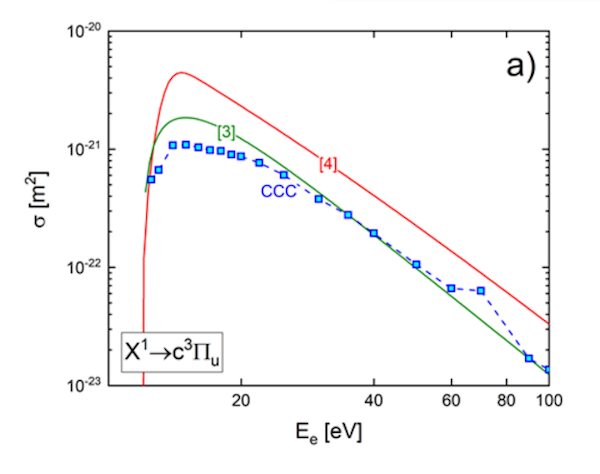H2 collisional cross sections for fusion applications
Details
Population models are a prerequisite for performing qualitative analysis of population densities measured in plasmas or predicting the dependence of plasma emission on parameter variations [1]. Usually applied to low-pressure, low-temperature plasmas are collisional radiative (CR) models. Needed as input data for such models is an extensive set of probabilities for excitation and de-excitation processes in the atomic or molecular species under investigation. The accuracy of the model results is strongly correlated to the accuracy of the used input data.
Atomic and molecular hydrogen is present in a wide variety of different plasma applications, including process plasmas or the edge plasma of fusion devices. Due to the simple structure of the hydrogen atom, well-benchmarked sets of input data exist, consisting of – amongst others – cross sections for electron collision excitation, ionization and different recombining channels. Thus, construction of CR models for the hydrogen atom is straightforward [2]. In contrast, due to the rotational and vibrational degrees of freedom the internal structure of the hydrogen molecule is much more complex. One consequence of this complex internal structure is that significant deviations exist between electron-impact excitation cross sections taken from different literature sources [2], resulting in a higher uncertainty of the results from CR models for the hydrogen molecule. Two widely used data sets from literature are the ones from [3], created by semiempiric methods based on experimental information and phenomenological extensions of the Born approximation into the low-energy region and [4], a summary of recent measurements and calculations.
For further improving the accuracy of CR models for molecular hydrogen it is highly desirable to establish a comprehensive and well benchmarked data set for vibrationally or ro-vibrationally resolved excitation cross-sections. Measurements of such cross sections are typically limited to scattering on the ground vibrational level of the target molecule, and hence there is significant demand for accurate theoretical modelling of scattering on excited levels of the hydrogen molecule.
The group at Curtin University has utilized a spheroidal-coordinate formulation of the molecular convergent close-coupling (CCC) method [5] to perform accurate adiabatic-nuclei (AN) calculations of electron-impact vibrationally-resolved excitation cross sections for electron collisions with molecular hydrogen and its isotopologues. Figure 1 shows – as an example – vibrationally averaged CCC cross sections for electron collision excitation from the ground state X1 of the hydrogen molecule into the excited states c3 and d3, compared to the data from [3] and [4]. It can be seen that the CCC data is close to the semiempiric cross section from [3] for excitation of c3 while for excitation of d3 it is close to the more recent data set given in [4]. The comprehensive set of CCC cross sections has been additionally used to obtain cross sections for dissociative excitation for scattering on all bound vibrational levels of the molecular hydrogen ground electronic state [6], dissociation into neutral fragments from the ground vibrational level [7], and to study vibrational excitation of the electronic ground state via electron-impact excitation and radiative decay [8].


Present in the group at IPP Garching is comprehensive knowledge in the setup, benchmark and applications of CR models. Currently available are CR models for numerous atomic and molecular species, based on the flexible solver Yacora and benchmarked versus plasma experiments available in the group.
The collaboration of the two groups brings together the detailed dataset for e–H2 collisions produced at Curtin University with the experience in plasma modelling present at IPP Garching: The CCC data are on the way to be implemented into the latest version of the Yacora CR model for H2 [2]. This model will be benchmarked versus and applied to molecular radiation measured in small-scale lab experiments available at the IPP group but also through collaborations with other research groups. An additional benchmark will be done versus negative ion sources for neutral beam heating at ITER [9].
Research Groups and other collaborators
| Fantz Group | ITER Technology and Diagnostics Division (ITED), Max Planck Institute for Plasma Physics (IPP), Garching, Germany | |
| Fursa Group | Faculty of Science and Engineering, Curtin University, Australia |
References
- [1] U. Fantz, "Basics of plasma spectroscopy", Plasma Sources Science and Technology 15, S137 (2006).
- [2] D. Wünderlich and U. Fantz, "Evaluation of State-Resolved Reaction Probabilities and Their Application in Population Models for He, H, and H2", Atoms 4, 26 (2016).
- [3] W. T. Miles, R. Thompson and A. E. S. Green, "Electron‐Impact Cross Sections and Energy Deposition in Molecular Hydrogen", Journal of Applied Physics 43, 678-686 (1972).
- [4] R. K. Janev, D. Reiter and U. Samm, "Collision Processes in Low-Temperature Hydrogen Plasmas", Report Jül–4105 (2003).
- [5] J. K Tapley et al., "Vibrationally resolved electron-impact excitation cross sections for singlet states of molecular hydrogen", Journal of Physics B: Atomic, Molecular and Optical Physics 51, 144007 (2018).
- [6] J. K. Tapley et al., "Electron-impact dissociative excitation cross sections for singlet states of molecular hydrogen", Physical Review A 98, 032701 (2018).
- [7] L. H. Scarlett et al., "Electron-impact dissociation of molecular hydrogen into neutral fragments", The European Physical Journal D 72, 34 (2018).
- [8] L. H. Scarlett et al., "Vibrational excitation of the H2 X(1Σ+g) state via electron-impact excitation and radiative cascade", Plasma Sources Science and Technology 28, 025004 (2019).
- [9] B. Heinemann et al., "Towards large and powerful radio frequency driven negative ion sources for fusion", New Journal of Physics 19, 015001 (2017).